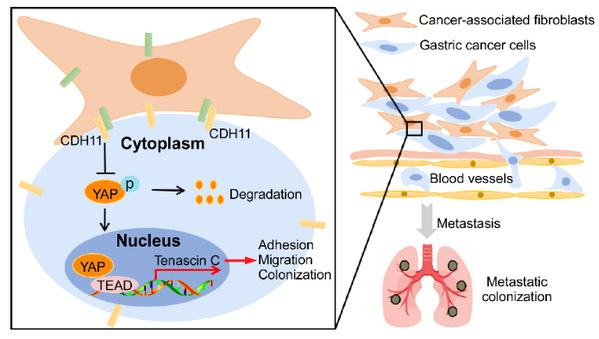The interaction between tumor cells andcells in the microenvironment is crucial for tumor metastasis. At present,there is an in-depth understanding of paracrine signaling-mediated cell-to-cellinteractions in the tumor microenvironment and its role in tumor metastasis.For example, during the progression of gastric cancer, a variety of cytokines,growth factors and extracellular matrix proteins have been reported to promotethe progression and metastasis of tumor cells. Clinically, we have noticed aphenomenon for a long time. Whether it is a solid primary tumor or a metastatictumor tissue, many tumor cells closely contact with stromal cells, especiallythose tumor cells at the frontier of invasion. The direct cell-cell contact isusually mediated by juxtacrine signaling. However, the roles of juxtacrinesignaling in gastric cancer metastasis remains unclear.
Recently, the research group led by Prof.ZHUO Wei and Prof. ZHOU Tianhua at the School of Basic Medicine of ZhejiangUniversity published a research paper entitled Cadherin 11-mediated juxtacrineinteraction of gastric cancer cells and fibroblasts promotes metastasis viaYAP/tenascin-C signaling in Science Bulletin. They uncovered a novel mechanismby which Cadherin 11-mediated juxtacrine signaling in gastric cancer cells andfibroblasts activates the YAP/Tenascin-C axis to promote gastric cancermetastasis.
The Cadherins family is a class oftransmembrane glycoproteins that mediate the juxtacrine signaling betweencells. The researchers took cadherins as the entry point to study the role ofjuxtacrine in gastric cancer. They used the Cancer Genome Atlas (TCGA) databaseand multiple gastric cancer sample validation cohorts to systematically screenthe cadherins family. It was found that cadherin 11 (CDH11) was the onlyadhesion molecule member whose expression was significantly up-regulated ingastric cancer tissue, correlated with TNM stage, and significantly with poorprognosis of patients. Mouse experiments suggest that CDH11 plays a key role ingastric cancer cell metastasis. Next, the researchers analyzed the relationshipbetween CDH11 and various microenvironmental cells, and found that theexpression level of CDH11 in gastric cancer tissue was closely related to themarkers of cancer associated fibroblasts (CAFs), suggesting that CDH11 may beinvolved in the interaction between gastric cancer cells and CAFs. Moreover,the researchers established in vitro cell-cell adhesion models, co-culturemodels, and in vivo co-metastasis models. They found that CDH11 mediates theadhesion interaction between gastric cancer cells and fibroblasts, and promotesthe migration of gastric cancer cells, tumor sphere formation, and in vivometastasis. Mechanistically, the researchers revealed that CDH11-mediatedjuxtacrine between gastric cancer cells and fibroblasts can activate the YAPsignaling pathway in gastric cancer cells, promote the localization of YAP inthe nucleus, and upregulate the transcriptional expression of Tenascin-C (TNC).Further rescue assays verified that the YAP pathway and target gene TNC areinvolved in the promotion of gastric cancer cell migration, tumor sphereformation induced by CDH11. Finally, data from multiple gastric cancer samplecohorts indicated that CDH11, YAP, and TNC were up-regulated in gastric cancer,and the expression levels of these genes were closely correlated andsignificantly correlated with poor prognosis in gastric cancer patients.

A new juxtacrine signaling between gastriccancer cells and tumor associated fibroblasts promotes gastric cancermetastasis. In conclusion, this study elucidates theimportant role of juxtacrine in the interaction between gastric cancer cellsand tumor associated fibroblasts and in gastric cancer metastasis. TheCDH11-YAP-TNC juxtacrine signaling revealed by this work will be helpful inunderstanding cell communications in tumor microenvironment. Furthermore, thiswork also provides potential targets for the clinical treatment and prognosisof gastric cancer metastasis.












